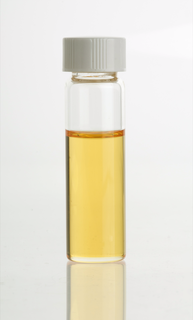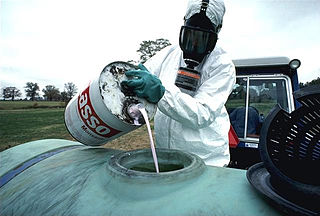
Dichlorodiphenyltrichloroethane, commonly known as DDT, is a colorless, tasteless, and almost odorless crystalline chemical compound, an organochlorine. Originally developed as an insecticide, it became infamous for its environmental impacts. DDT was first synthesized in 1874 by the Austrian chemist Othmar Zeidler. DDT's insecticidal action was discovered by the Swiss chemist Paul Hermann Müller in 1939. DDT was used in the second half of World War II to control malaria and typhus among civilians and troops. Müller was awarded the Nobel Prize in Physiology or Medicine in 1948 "for his discovery of the high efficiency of DDT as a contact poison against several arthropods".

Pesticides are substances that are meant to control pests, including weeds. The term pesticide includes all of the following: herbicide, insecticides nematicide, molluscicide, piscicide, avicide, rodenticide, bactericide, insect repellent, animal repellent, antimicrobial, and fungicide. The most common of these are herbicides which account for approximately 80% of all pesticide use. Most pesticides are intended to serve as plant protection products, which in general, protect plants from weeds, fungi, or insects.

Silent Spring is an environmental science book by Rachel Carson. The book was published on September 27, 1962, documenting the adverse environmental effects caused by the indiscriminate use of pesticides. Carson accused the chemical industry of spreading disinformation, and public officials of accepting the industry's marketing claims unquestioningly.

Cedar oil, also known as cedarwood oil, is an essential oil derived from various types of conifers, most in the pine or cypress botanical families. It is produced from the foliage, and sometimes the wood, roots, and stumps which have been left after cutting of trees for timber extraction. It has many uses in medicine, art, industry and perfumery, and while the characteristics of oils derived from various species may themselves vary, all have some degree of bactericidal and pesticidal effects.

Insecticides are substances used to kill insects. They include ovicides and larvicides used against insect eggs and larvae, respectively. Insecticides are used in agriculture, medicine, industry and by consumers. Insecticides are claimed to be a major factor behind the increase in the 20th-century's agricultural productivity. Nearly all insecticides have the potential to significantly alter ecosystems; many are toxic to humans and/or animals; some become concentrated as they spread along the food chain.

Piperonyl butoxide (PBO) is a waxy white solid organic compound used as a synergist component of pesticide formulations. That is, despite having no pesticidal activity of its own, it enhances the potency of certain pesticides such as carbamates, pyrethrins, pyrethroids, and rotenone. It is a semisynthetic derivative of safrole.

Integrated pest management (IPM), also known as integrated pest control (IPC) is a broad-based approach that integrates practices for economic control of pests. IPM aims to suppress pest populations below the economic injury level (EIL). The UN's Food and Agriculture Organization defines IPM as "the careful consideration of all available pest control techniques and subsequent integration of appropriate measures that discourage the development of pest populations and keep pesticides and other interventions to levels that are economically justified and reduce or minimize risks to human health and the environment. IPM emphasizes the growth of a healthy crop with the least possible disruption to agro-ecosystems and encourages natural pest control mechanisms." Entomologists and ecologists have urged the adoption of IPM pest control since the 1970s. IPM allows for safer pest control.

Citrus fruits are the highest-value fruit crop in terms of international trade. There are two main markets for citrus fruit:

Pest control is the regulation or management of a species defined as a pest, a member of the animal kingdom that impacts adversely on human activities. The human response depends on the importance of the damage done, and will range from tolerance, through deterrence and management, to attempts to completely eradicate the pest. Pest control measures may be performed as part of an integrated pest management strategy.
Biopesticides, a contraction of 'biological pesticides', include several types of pest management intervention: through predatory, parasitic, or chemical relationships. The term has been associated historically with [biological control] – and by implication – the manipulation of living organisms. Regulatory positions can be influenced by public perceptions, thus:

Mosquito control manages the population of mosquitoes to reduce their damage to human health, economies, and enjoyment. Mosquito control is a vital public-health practice throughout the world and especially in the tropics because mosquitoes spread many diseases, such as malaria and the Zika virus.
Non-pesticidal Management (NPM) describes various pest-control techniques which do not rely on pesticides. It is used in organic production of foodstuff, as well as in other situations in which the introduction of toxins is undesirable. Instead of the use of synthetic toxins, pest control is achieved by biological means.

Pyriproxyfen is a pesticide which is found to be effective against a variety of insects. It was introduced to the US in 1996, to protect cotton crops against whitefly. It has also been found useful for protecting other crops. It is also used as a prevention for flea control on household pets, for killing indoor and outdoor ants and roaches. Methods of application include aerosols, bait, carpet powders, foggers, shampoos and pet collars.

Bendiocarb is an acutely toxic carbamate insecticide used in public health and agriculture and is effective against a wide range of nuisance and disease vector insects. Many bendiocarb products are or were sold under the tradenames "Ficam" and "Turcam."
Agricultural spray adjuvants are used to enhance the effectiveness of pesticides, herbicides, insecticides, fungicides and other agents that control or eliminate unwanted pests. As with medical adjuvants, agricultural spray adjuvants are not themselves active in controlling or killing pests. Instead, these additives modify some property of the spray solution, which improves the ability of the pesticide to penetrate, target or protect the target organism. Among the typical types of ingredients used are surfactants, emulsifiers, oils and salts. Each of these ingredients, and others, modifies the spray solution itself to improve such properties as spreading, penetration, droplet size or other characteristics.

Pesticide application refers to the practical way in which pesticides are delivered to their biological targets. Public concern about the use of pesticides has highlighted the need to make this process as efficient as possible, in order to minimise their release into the environment and human exposure. The practice of pest management by the rational application of pesticides is supremely multi-disciplinary, combining many aspects of biology and chemistry with: agronomy, engineering, meteorology, socio-economics and public health, together with newer disciplines such as biotechnology and information science.
Ultra-low volume application of pesticides has been defined as spraying at a Volume Application Rate (VAR) of less than 5 L/ha for field crops or less than 50 L/ha for tree/bush crops. VARs of 0.25 – 2 l/ha are typical for aerial ULV application to forest or migratory pests.

The impact of pesticides consists of the effects of pesticides on non-target species. Pesticides are chemical preparations used to kill fungal or animal pests. Over 98% of sprayed insecticides and 95% of herbicides reach a destination other than their target species, because they are sprayed or spread across entire agricultural fields. Runoff can carry pesticides into aquatic environments while wind can carry them to other fields, grazing areas, human settlements and undeveloped areas, potentially affecting other species. Other problems emerge from poor production, transport and storage practices. Over time, repeated application increases pest resistance, while its effects on other species can facilitate the pest's resurgence.

Shade-grown coffee is a form of the beverage produced from coffee plants grown under a canopy of trees. A canopy of assorted types of shade trees is created to cultivate shade-grown coffee. Because it incorporates principles of natural ecology to promote natural ecological relationships, shade-grown coffee can be considered an offshoot of agricultural permaculture or agroforestry. The resulting coffee is usually sold as "shade-grown".
Tree injection, also known as trunk or stem injection, is a method of target precise application of pesticides, plant resistance activators, and fertilizers into the xylem vascular tissue of a tree with the purpose of protecting the tree from pests or nutrition for correction of nutrient deficiencies. This method largely relies on harnessing the tree's vascular system to translocate and distribute the active compounds into the wood, canopy and roots where protection or nutrition is needed. Tree injection is currently the most popular method for control of damaging insects, pathogens, and nematodes in landscape tree care. It has been developed primarily for use on large size trees and in proximity of urban areas where ground- and air-spray applications are impractical due to substantial drift-driven pesticide losses or not allowed due to potential human exposure. However, the prime driver of tree injection use has been a wide spread need for control of many invasive tree pathogens and insects pests. The most infamous examples are that of Ophiostoma fungi that cause Dutch Elm Disease (DED) and insect Emerald ash borer which have specific biologies that lead to severe internal damage of wood and thus tree death, and which make their management extremely difficult or inefficient with classical pesticide application methods. Trunk injection for tree protection is viewed as environmentally safer alternative for pesticide application since the compound is delivered within the tree, thus allowing for selective exposure to plant pests. In landscapes and urban zones trunk injection significantly reduces the non-target exposure of water, soil, air, and wildlife to pesticides and fertilizers. In the last 20 years, tree injection is gaining momentum with the development and availability of new, efficient injection devices and injectable and xylem mobile formulations of pesticides, biopesticides and nutrients. Further, a number of newly occurring and fast spreading invasive insect pests and diseases such as Polyphagous Shot Hole Borer (PSHB) Euwallacea sp., which vectors plant pathogenic fungus Fusarium euwallaceae, and Sudden Oak Death (SOD) caused by an Oomycete Phytophthora ramorum, establish the use of trunk injection as the most efficient tree protection technique in landscapes and urban forestry.














